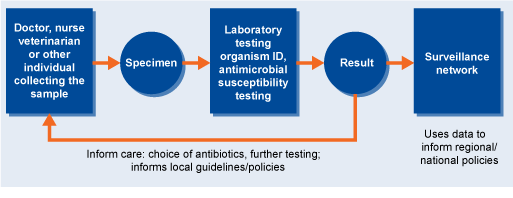3 Who is ‘the AMR surveillance professional’?
The responsibility for AMR surveillance is distributed across various professional roles – for example:
- clinicians, nurses and veterinarians collect samples and document the clinical information
- laboratory staff perform tests
- data scientists and epidemiologists analyse, interpret and report data
- senior managers and policy-makers use the data to develop policy and practice
- clinicians, veterinarians and pharmacists use the data to treat patients.
However, even if you do not have a specific, identifiable role in a surveillance programme, everyone involved in animal and human healthcare has a role to play in reducing AMR.
Activity 1: You as an AMR surveillance professional
The courses in this programme are designed for AMR surveillance professionals working in all of these roles, and similar roles with different names. We have grouped the roles in Part 1 of this activity. Spend a couple of minutes reviewing Table 1 to find the group that best fits your current role, or the role you are planning to undertake. Everyone has a role to play in reducing AMR, so even if you do not find your role listed in Table 1, you may find some of the materials in this programme relevant to your work.
| Category | Description |
|---|---|
| Laboratory professionals | Laboratory technicians/assistants, technologists, laboratory scientists (across sectors) |
| Senior laboratory professionals | Head/manager of a laboratory, head of unit (across sectors) |
| Clinical service professionals | Clinicians, nurses, pharmacists, clinical officers |
| Veterinarian service professionals | Veterinarians, para-veterinarians, field/veterinarian officers, veterinarian pharmacists |
| Senior management (clinical) | Head of hospital, chair of IPC committees/drugs and therapeutics/resources, superintendents |
| Senior management (veterinary) | Director/deputy director of veterinarian services |
| Policy-makers | AMR Secretariat, government departments of health/agriculture/livestock/fisheries, WHO, FAO, WOAH, UNEP |
| Data scientists and epidemiologists | Data scientists, epidemiologists |
Earlier in the course you were introduced to the local AMR surveillance process. Look at the figure again (Figure 4) – can you identify where your role fits within this process? If you are not sure, you may like to discuss this with colleagues. Not everyone’s role will fit within the surveillance process; however, even if you do not have a specific or identifiable role in a surveillance programme, everyone involved in animal and human healthcare has a role to play in reducing AMR.
Discussion
Note that the information in Figure 4 is not intended to precisely define where your role fits into the local AMR surveillance process. It is based on a generalised overview of surveillance processes, so the exact nature of your role will depend on many factors including the sector that you work in, your experience and the size of your workplace.
2 Introducing AMR surveillance





